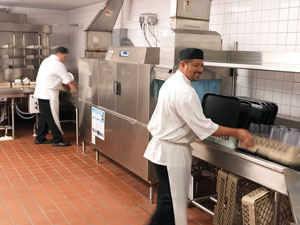
In high-volume commercial kitchens, dishmachines use a lot of water. High-efficiency models curb the amount of water and energy use, but that’s only part of the story. How you operate and maintain your warewashers has a huge effect, not only on usage but on your utility costs, as well.
So, what can you do? Here are four tips to save water and energy—and maximize the performance of rack-conveyer machines.
1. Install a water meter and monitor water usage every day. Whether your dishmachine has one hot water connection or two, install a water meter on each—or better yet, wireless smart meters, which are available at comparable costs. According to the Food Service Technology Center, sub-metering allows you to set a performance benchmark and monitor water usage daily rather than waiting for usage data that’s provided monthly or every other month by your utility company.
2. Scrape and load wares properly. Overspray, which sends water shooting out of the machine at the load and unload ends, can occur when employees lay certain wares flat in order to fit them inside the machine, blocking the wash and rinse sprayers. Sheet and hotel pans, trays, cutting boards and the like are common culprits.
Even if an operation has a newer, more efficient machine that uses less water overall, using it in a way that generates overspray can diminish the water savings.
When specifying a new dishmachine, make sure the equipment has a tall enough opening to accommodate the sheet and hotel pans, trays, cutting boards and other items upright, at an angle. Some regular-height machines can do so, but some cannot.
3. Keep up with ongoing maintenance and cleaning. Without proper maintenance, even the most efficient dishmachines will be energy and water hogs. Pressure regulators and gauges can break often, but the damage may not be detected during normal operation.
Perform planned maintenance during off hours to make sure your machines are running properly and using water and energy as efficiently as possible, the FSTC advises. This includes cleaning and deliming sensors, spray arms and heating elements.
4. Train staff well. Proper employee training—not only for pre-scrapping and loading the machine correctly but also operating it as recommended—will help avoid problems. Work with your manufacturers’ rep to make sure staff is trained. Also, make sure your employees and your maintenance crew communicate clearly with each other.
This information first appeared in the FER story, “Maximizing Rack-Conveyer Efficiency.”
RELATED CONTENT
- Advertisement -
- Advertisement -
- Advertisement -
TRENDING NOW
- Advertisement -
- Advertisement -
- Advertisement -


